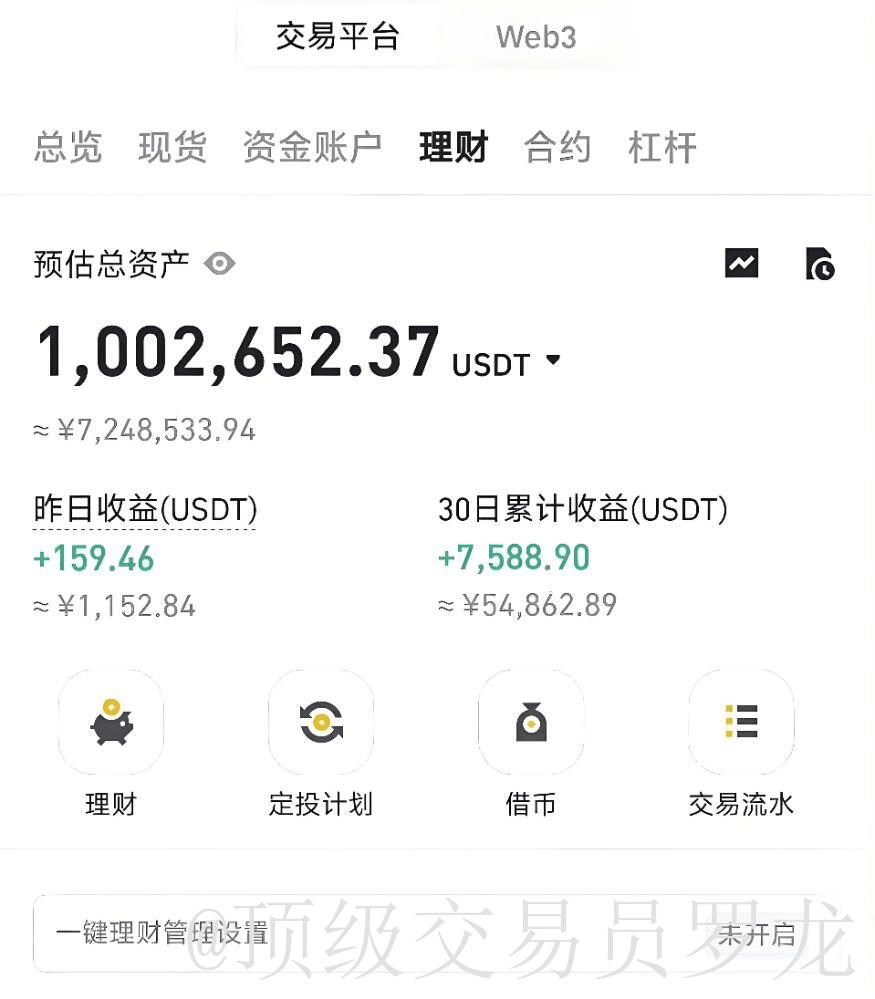I have been in the cryptocurrency space for ten years. Six years ago, I quit my job to trade cryptocurrencies. What truly changed me was a night five years ago when an old mentor's words struck me profoundly, helping me align my position and understand the eight major periods that cryptocurrency traders must go through, constantly reflecting on them, using them as a mirror, and finally retrieving everything I had lost.
Perhaps in the eyes of some, retail investors are always the lambs waiting to be slaughtered!
If you are preparing to enter the cryptocurrency space, I sincerely hope this article can help you. As someone who has decent summarizing abilities and can express myself reasonably well, I believe my thoughts may be of some help to you. Alright, enough chit-chat, let's get straight to the point~
When it's hard to make a selling decision in cryptocurrency trading, ask yourself: If your analysis is correct, why is the market moving in the opposite direction? The only reason is that you're wrong because the market never makes mistakes!
Trading cryptocurrencies is not a gamble; wealth is a marathon.
Those who envy the short-term end up as chives.
Slow is fast; stability leads to wins.
These 8 iron laws are lessons bought with hard-earned money:
1. Supplementing positions is only for survival; don't fantasize about getting rich.
It's okay to add positions to average down costs if you're trapped, but expecting a complete turnaround? The market makers are waiting for you to think that way.
2. It's always especially quiet before the storm.
The longer the sideways movement, the more severe the change will be; don't relax your vigilance in tranquility.
3. When the rise is the wildest, it's time to fasten your seatbelt.
Every straight-line surge will take a breath; if the K-line shrinks into a triangle, the market is holding back a big move.
4. Buy when blood flows like rivers, sell when drums are beating.
When the aunties outside the exchange start discussing Bitcoin, it's time to quietly retreat.
5. Don't chase during a sharp rise, don't be scared during a sharp drop, and don't fidget during consolidation.
Don't rush to exit when the market is soaring; don't be afraid to catch a knife during a cliff drop; only control your actions during sideways movements.
6. Look for the ceiling when rising, and find the floor when falling.
Previous highs are high-pressure lines; previous lows are shelters; keep a close eye on these two points.
7. Always leave a bullet.
Those who go all-in are either geniuses or daredevils - unfortunately, geniuses are rare in the market.
8. Trading cryptocurrencies is essentially about cultivating the mind.
FOMO at bullish candles and cut losses at bearish candles? You're playing with cryptocurrency, not a heartbeat simulator.
Remember, the whales that live long grow slowly.

The golden rule of trend trading: The art of combining large and small cycles - the large cycle sets the direction, and the small cycle finds opportunities.
The large cycle is your navigator (daily/weekly):
Observe the trend: Instantly recognize whether it's a bull market, bear market, or sideways market, and solve the soul-searching question of 'should I take action?'
Find the key: Lock onto those support and resistance levels that make prices 'unbearable to stop'; these are the places most likely to produce major trends.
The small cycle is your sniper scope (4-hour/15-minute):
Wait for the opportunity: Find the best entry point within the large trend, just like waiting for a bus; there's no need to chase after it.
Establish defense lines: Draw stop-loss lines in advance, understand your losses, and ensure your gains are solid.
Two, the four major mysteries of cycle interaction.
Suppression effect:
When the small cycle hits the high point of the large cycle, it's like hitting a ceiling. Chasing at that moment? Be careful of getting knocked out!
Breakthrough effect:
When the small cycle violently breaks through the key point of the large cycle, it's like opening up the meridians; the trend might take off.
Support effect:
When the large trend is upward, and the small cycle pulls back to the large cycle's support level, it's like jumping on a trampoline; it often bounces higher.
Characteristics of a healthy trend:
A truly good trend will have the large and small cycles cooperating seamlessly - higher highs and higher lows, like climbing stairs, one step at a time.
Practical mindset:
Make big decisions small, wait for small confirmations of the big ones. The long-term cycle tells you where to go, and the short-term cycle tells you when to step. Remember, the market is always playing psychological games with you, and the different cycles are your secret weapon.
Key points:
Don't be greedy; withdraw a portion of your profits first for safety.
Don't hold onto losing positions; cut losses directly if the floating loss exceeds 2%. The market will not pity you.
Don't play recklessly; rolling positions are only suitable for trending markets; don't seek death in a sideways market.
The core of making money in the cryptocurrency space is two points: find the trend + execute strictly.
The most important iron law:
If the price falls below the 60-day line on the day of purchase, you must liquidate immediately! Don't hesitate, don't fantasize. Remember: Surviving in the cryptocurrency market is more important than anything.
This method seems simple but excels in stability. I have avoided countless crashes with this simple method and captured several major trends. Sometimes, the simplest methods are the most effective.
Those who survive in this field have their own survival codes. My code is these 7 sentences - they helped me survive the wild fluctuations and live quite well.
When the leader moves, the whole market comes alive.
Every track has a leading figure. When the leader starts charging, don’t rush to chase; turn around and look at the second and third in line - opportunities often hide within the following crowd.
Volume does not lie.
Slowly accumulate during quiet times, fully invest during volume at the bottom, and liquidate during explosive volume at the top. Volume is the most honest indicator; it is more reliable than any analyst.
Low volume is a friend; high volume is an alarm.
Is volume shrinking during a pullback? That's the main force taking a break. Is volume suddenly expanding? Be careful; they might be offloading.
Indicators can speak.
Buy when RSI hits a low three times, sell when it hits a high three times. Buy below 10 with your eyes closed, run away above 85. New highs in price but weak indicators? That's the market coughing to remind you. KDJ is the compass for short-term players, while long-term players should pay more attention to TRIX.
Forget the fairy tales of 'good coins' and 'bad coins.'
The market only recognizes strength and weakness. Strong coins are like armored warriors, while weak coins are like leaking tires - no matter how nice the story sounds, the flow of funds is the real truth.
Moving averages are the market makers’ hidden cards.
Buy on golden crosses, sell on death crosses. When the 5-day and 10-day lines are supporting, you can lie down comfortably; be alert when breaking the 10-day line, and a turn in the 5-day line is a signal to retreat. Market makers protect their thresholds like protecting their own doorstep; the 10-day line is often their baseline.
Trends are your allies.
Those who dare to rise will continue to rise; those who pretend to be dead may truly die. Don't fight against the trend, and especially don't fight against yourself - the market is stubborn against those with different feelings.
Here are three blood and tears mantras:
Don't chase during sharp rises, don't panic during deep drops, and control your hands during consolidation.
Buy on bearish candles, sell after bullish candles.
Long periods of consolidation must change; clear out at high-level breaks, and fill up at low-level breakouts.
Remember, these are not spells, but scars of survival. The market is always changing, but human nature has never changed - that's the essence of the game.

This market is always repeating the same secret: 90% of retail investors watch the news to trade cryptocurrencies, 9% of smart people watch the movements of the market makers, and the 1% of wolf-like players are dissecting market genes using daily moving averages.
Step one: Verify the moving averages. Treat the daily moving average as three doctors with distinct personalities - the 5-day line is the head of emergency, the 30-day line is the internal medicine expert, and the 60-day line sits in a grand chair in the specialist clinic. When the head of emergency suddenly perks up and rushes to check the two old experts (the 5-day line crosses above the 30/60-day line), this is the signal that the market is preparing for ICU rescue. Conversely, if you see the head of emergency slipping and rolling down from the expert's chair (the 5-day line crosses below the 30/60-day line), don’t hesitate; immediately adjust your positions.
Step two: Establish a trading system to prevent impulsiveness.
Now, please stick a note on your trading interface with bold markers that says: Moving averages are fighting, mere mortals withdraw. When the 5-day and 30-day lines are intertwined like a twisted doughnut, rushing into the market is equivalent to rolling dice to guess odd or even. True hunters only pull the trigger when the three lines march in the same direction.
Here's an unconventional cold fact: In the cryptocurrency space where wild fluctuations are a norm, the daily moving average strategy is increasingly simple yet deadly. Just like true martial arts masters never need to display fifty opening moves; a 5-day line breakthrough is the signal to draw your sword, and a 60-day line turning is the time to sheathe it.
Step three: Weld discipline into your trading platform.
I’ve seen too many people write their trading plans on napkins, only to tear them up in fear during a sudden market spike. The most brutal and merciful aspect of the daily moving average strategy is that it forces you to become an emotionless signal execution machine.
Here's a dark humor: A trader who had stabilized profits using daily moving averages for three years received a warning at his wedding last year that the 5-day line had broken. He had to sneak into the washroom to close his position before coming back to exchange rings. The bride later scolded him, but after seeing the account balance, she silently replaced his monitor with a top-end one.
(Inscribe this sentence in your brain: You can doubt your actions, but never doubt the already formed consensus of moving averages.)

Real rolling positions are not gambling, but using mathematics to crush the market. Here are three core logics:
1. The 'stop-loss line' is a false proposition.
Most people set a 3% stop-loss and end up cutting losses repeatedly.
True risk control is 'volatility anchoring.' For example, every time ETH breaks through the middle of the weekly Bollinger Bands, use 5x leverage during the pullback phase, increasing the stop-loss space to 8%, but reducing the triggering probability by 60% (data backtested from 2023 to the present).
2. The timing for adding positions = 50% pullback level + volume shrinkage.
For example, when BTC drops from 70,000 to 65,000, if the 4-hour chart shows a 'long lower shadow + volume shrinking to MA20', the success rate of adding positions triples. Blindly pyramid adding = suicide.
3. Profits must be 'locked across cycles.'
Withdraw your principal every time you make a 30% profit, and let the profits roll on. Remember: The money in your exchange account is just a number; the money in your wallet is yours.
(To prevent the strategy from being misused, the specific parameters and cryptocurrency selections are not disclosed for now, but you must at least know 'what is a convex position.')
Warning: If you're still opening positions based on 'feelings,' no strategy can save you.
How do true experts play?
Withdraw your principal first after making money, let the profits continue to run; total losses must never exceed 30%; only take action during market panic or frenzy; otherwise, just watch the show.
The market always follows a pattern:
After many drops, a rebound is certain. The longer the sideways movement, the more violent the breakout. When everyone in the group is shouting 'take off', hurry up and run.
Lastly, a heart-wrenching statement: In this market, 90% of people are 'chives' (easy targets), while 10% earn 90% of the money. Which one do you want to be? Will you continue to give money away, or learn the rules and become a hunter? Choose for yourself.
The market is like a knife; how can retail investors survive in a sea of blood?
'One general's success buries thousands of bones'; the recent market massacre feels like cutting through chaos - regardless of the surges or drops, by the time you react, you've already been cut down. You may not feel the pain, but you are already in pieces, without even a chance to cry out. A fight between Trump and Musk can cut you; a change in the direction of China-US negotiations can cut you; whether the Russia-Ukraine talks go smoothly can cut you; even if Trump says something in his sleep, it can cut you.
The wisest choice these days is to cash out as soon as you make a profit. Preserve your principal and ensure a baseline for living; even if you encounter corrections, you won't sustain serious injuries. Watching the market bleed out, with corpses everywhere, the sense of desolation is piercing - most retail investors just want to earn some pocket money, but one operation ends up costing a whole pig; how do they live?
Economic recession, real estate pressure, employment difficulties, high debts, blocked foreign trade; who isn't struggling in the grind of life? Nobody wants to touch contracts, but looking at the few coins in your pocket, you have to choose this high-risk path - otherwise, how do you bear the burdens of life?
